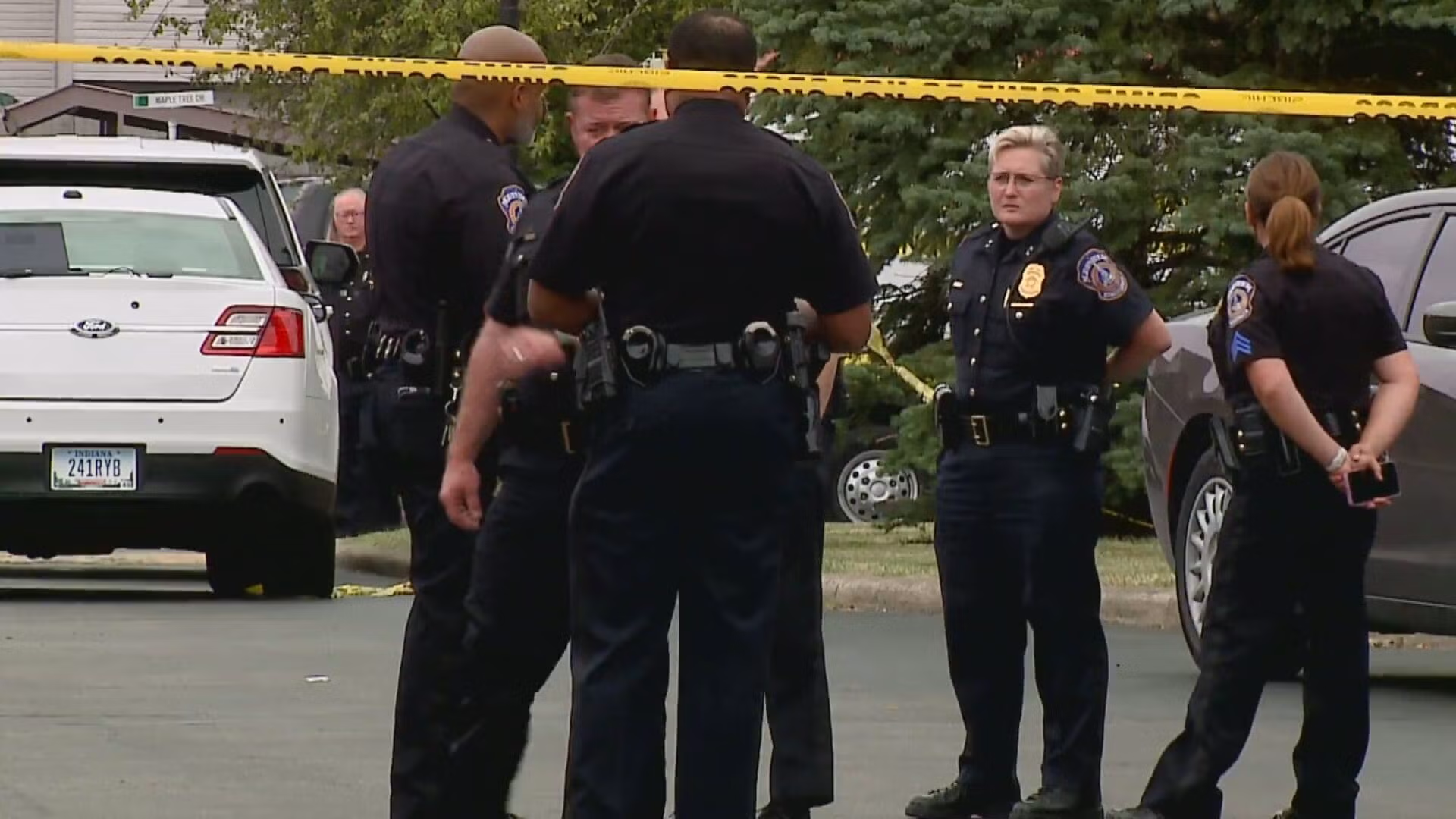“Imagine you’re streaming a protest from a public sidewalk when an officer says, ‘Don’t come any closer.’ Can you keep recording? Can they arrest you just for being within 25 feet? This guide breaks down what the Indiana Buffer Zone Law Injunction means right now—plain English, zero fluff.”
What Is Indiana’s 25-Foot “Buffer” Law?
Indiana’s original “buffer” statute makes it a Class C misdemeanor to “knowingly or intentionally approach within 25 feet of a law enforcement officer” performing official duties after the officer orders you to stop approaching. The law is codified at Ind. Code § 35-44.1-2-14.
Statutory text and the police 25-foot rule
Two verbs do the work: an officer must order you to stop approaching, and you must keep approaching into that 25-foot zone to violate the statute. The text doesn’t expressly grant authority to push you back to a point 25 feet away; it criminalizes approaching closer after a stop-approach order. The Seventh Circuit emphasized this textual point repeatedly.
How the law interacts with Indiana’s emergency incident statute
Indiana also has an “emergency incident” law that lets officers define an incident area (often a 25-foot perimeter) and require people to leave. The Seventh Circuit explained these are not the same law and don’t fully overlap; the buffer law can apply much more broadly than an “emergency incident.”
Case Timeline: How We Got to the Injunction
The media coalition’s lawsuit and district court preliminary injunction
A coalition led by the Reporters Committee for Freedom of the Press (RCFP) sued state and local officials, arguing the buffer law is unconstitutional. In Sept. 2024, Chief Judge James Sweeney issued a preliminary injunction blocking enforcement, relying on the Fourteenth Amendment vagueness doctrine.
The Seventh Circuit appeal and August 2025 decision
On Aug. 5, 2025, a unanimous Seventh Circuit panel affirmed the district court’s decision to preliminarily enjoin the buffer law—finding the statute unconstitutionally vague because it invites arbitrary enforcement. The court also remanded for the district court to revisit the scope of the injunction in light of the Supreme Court’s new limits on universal injunctions in Trump v. CASA, Inc.
What the Seventh Circuit Actually Decided
Vagueness doctrine and Fourteenth Amendment due process
A law is void for vagueness if it fails to give people fair notice of what’s prohibited or if it encourages arbitrary, discriminatory enforcement. The Seventh Circuit accepted, for sake of argument, that people can gauge 25 feet and whether they’re approaching—but held the law is still unconstitutional because it lets officers order anyone to stop approaching for any reason (even “because the officer had a bad breakfast,” the court quipped), then arrest those who don’t obey. That’s too much discretion under the Fourteenth Amendment’s due process protections.
Why “approach” matters and why “move back” wasn’t the core issue
The court clarified that § 35-44.1-2-14 doesn’t authorize general “move-back” commands; it punishes approaching after a stop-approach order. Even so, because officers can issue that initial order without standards, the statute invites arbitrary enforcement—the precise vice the court condemned.
The Injunction’s Scope After the CASA Decision
Scope of relief and universal injunctions: what the remand means
In Trump v. CASA, Inc. (June 27, 2025), the Supreme Court sharply limited universal (nationwide/statewide) injunctions, saying injunctions should give complete relief to the plaintiffs, not to everyone. The Seventh Circuit told the district court to revisit the breadth of its injunction in light of CASA—but it affirmed that the plaintiffs get injunctive protection. The district court must now decide how broad the order needs to be to make the plaintiffs whole (for instance, journalists rely on interviews with members of the public who also need freedom to stand nearby).
Practical impact for non-parties (press and public) right now
Bottom line: the Seventh Circuit affirmed preliminary relief and remanded to fine-tune its scope. Until the district court modifies the order, the case remains in a posture where enforcement is blocked consistent with the district court’s injunction, but the court on remand may narrow it to what’s necessary for the plaintiffs’ complete relief. Watch the district court docket for updates.
How This Affects press freedom and newsgathering Today
The Seventh Circuit didn’t need to decide the First Amendment claims because it resolved the case on Fourteenth Amendment grounds. But the right to record police in public in the Seventh Circuit already has strong roots: in ACLU of Illinois v. Alvarez (2012), the court held Illinois couldn’t use its wiretapping law to criminalize recording on-duty police in public. That backdrop matters when officers try to push cameras away.
Public recording rights in the Seventh Circuit (ACLU v. Alvarez)
Key takeaways:
- You have a First Amendment right to record on-duty police in public spaces (subject to reasonable time, place, and manner limits).
- That doesn’t grant a right to interfere, obstruct, or ignore lawful orders tailored to legitimate safety or operational needs.
- The buffer law failed not because 25 feet is always too far, but because the statute made arrest hinge on unbounded officer discretion.
Examples: protests, crime scenes, traffic stops, and press gaggles
- Protests: If you’re stationary and an officer says “don’t come closer,” you can often stay put and keep filming (without approaching). The original buffer statute didn’t itself authorize ordering you to move back. Other laws (e.g., emergency incident zones) may still apply.
- Crime scenes: Officers may establish an emergency incident area with a fixed perimeter. That’s a different statute with different elements.
- Traffic stops: From a sidewalk, keeping a respectful distance while not approaching after a clear order typically reduces risk.
- Press gaggles: Identify yourself, ask for a safe spot, and note your distance on camera.
The “Reasonable Belief” Revision: What Changed in 2025?
The new § 35-44.1-2-15 and what to watch
In 2025, Indiana adopted a second buffer law (§ 35-44.1-2-15) that’s adjacent to the original but adds a “reasonable belief” requirement: an officer may order someone to stop approaching only if the officer reasonably believes the person’s presence within 25 feet will interfere with duties. It took effect July 1, 2025 and did not repeal the original law.
Does the revision fix the vagueness problem?
Maybe. The Seventh Circuit noted the new law is narrower but stressed the case before it concerned the original statute, which remains on the books. Expect future litigation to test whether the reasonable belief standard sufficiently cabins officer discretion and satisfies due process.
Do’s and Don’ts During the Injunction (Step-by-Step)
For journalists and legal observers
- Do keep recording from public places; state your role (“Press,” “Legal Observer”) early and clearly.
- Do ask, “Where would you like me to stand to stay out of your way?”
- Do narrate distance on camera (e.g., “I’m stationary, ~30 feet away”).
- Do carry a small measure app/lens with 25-foot marks; practice estimating.
- Don’t approach after an officer’s stop-approach order—that’s the trigger the statute uses.
- Don’t block, shove, cross police lines, or ignore lawful dispersal tied to safety or emergency incident perimeters.
For civic-minded residents and “copwatchers”
- Do hold your phone steady; speak calmly; avoid escalating language.
- Do record badge numbers, locations, and whether the officer mentioned “stop approaching.”
- Don’t assume an officer can demand you move back solely under the original buffer law; ask what authority they’re using (buffer vs. emergency incident).
- Do step back promptly if officers declare an emergency incident area or create a taped perimeter.
Important: This article is general information, not legal advice. Situations vary. If you’re at risk of arrest, follow lawful commands first and consult counsel later.
Key Precedents and Where Indiana Fits Nationally
- Seventh Circuit (2025): Upheld an injunction against Indiana’s buffer law under Fourteenth Amendment vagueness; remanded to consider injunction scope post-CASA.
- Nicodemus v. City of South Bend (2025): A separate Seventh Circuit case analyzing the First Amendment upheld application against a facial attack, emphasizing the statute’s “approach” focus and rejecting a “force field” reading. The later RCFP case turned on vagueness—a different lens.
- ACLU v. Alvarez (7th Cir. 2012): Recognized a right to record police in public.
- Other circuits: Third and Fifth Circuits have also recognized a public right to record (e.g., Fields and Turner).
What Comes Next Procedurally
- On remand, the district court will decide whether the injunction should remain broad or be narrowed to the plaintiffs while still giving them complete relief (for example, considering their reliance on ordinary citizens in man-on-the-street reporting).
- The State may push for a narrow scope; plaintiffs may argue that broad relief is necessary to protect their newsgathering.
- The new “reasonable belief” statute may draw its own challenges—watch for fresh filings testing whether it cures the vagueness problem.
FAQs
1) Is the Indiana Buffer Zone Law Injunction still in place after the Seventh Circuit’s decision?
Yes, the Seventh Circuit affirmed the preliminary injunction and sent the case back only to re-examine its scope in light of CASA. The plaintiffs remain protected; the district court will decide how broad the order needs to be.
2) Can officers still tell me to step back 25 feet?
Under the original buffer law, the state’s highest-level guidance says it criminalizes approaching after an order to stop approaching; it doesn’t itself authorize general “move-back” commands. But officers can rely on other laws (e.g., emergency incident perimeters). Ask what authority they’re invoking, and comply with lawful safety orders.
3) Does the ruling say I can always stand within 25 feet?
No. The ruling says officer discretion in issuing stop-approach orders is too open-ended under the Fourteenth Amendment. Separate laws (e.g., crime-scene perimeters) and time/place/manner limits can still apply.
4) What changed with the 2025 “reasonable belief” revision?
Indiana added § 35-44.1-2-15 requiring officers to have a reasonable belief that someone’s presence within 25 feet would interfere before issuing a stop-approach order. It didn’t repeal the original statute. Courts haven’t finished sorting out what that means in practice.
5) Do I have a right to record police in Indiana?
Yes. The Seventh Circuit has recognized a First Amendment right to record on-duty police in public (subject to reasonable limits). The injunction case turns on due process vagueness, not whether recording is protected.
6) What should journalists carry to stay safe and compliant?
Press ID, extra batteries, a distance app, high-visibility vest for night shoots, and a simple script: “Officer, I’m stationary, I’m not approaching, and I’ll move if you establish a perimeter. Where would you like me?”
7) I’m not in the plaintiff group—does the injunction help me?
The Seventh Circuit flagged questions about universal injunctions (CASA). The district court will decide how broad the order needs to be to give the plaintiffs complete relief—some breadth might be necessary because journalists rely on non-parties nearby. Keep tracking the docket.
8) Can I be arrested just for getting good audio within 25 feet?
If you approach after a stop-approach order under the original statute, that was the criminal trigger. The law’s vagueness (officer discretion to issue the order) is why enforcement is enjoined. Other statutes (like emergency incident rules) can still restrict proximity.
Conclusion and Next Steps
The Indiana Buffer Zone Law Injunction stands after the Seventh Circuit’s 2025 decision: the court found the law unconstitutionally vague and kept the preliminary injunction in place, while sending the case back to reconsider how broad the relief should be in a post-CASA world. For now, journalists and the public should keep recording, stay stationary when ordered not to approach, and comply with lawful safety perimeters. If you regularly cover police activity, consider consulting a First Amendment attorney to tailor newsroom protocols.
You May Also Like: What are SB 45 Cases?

